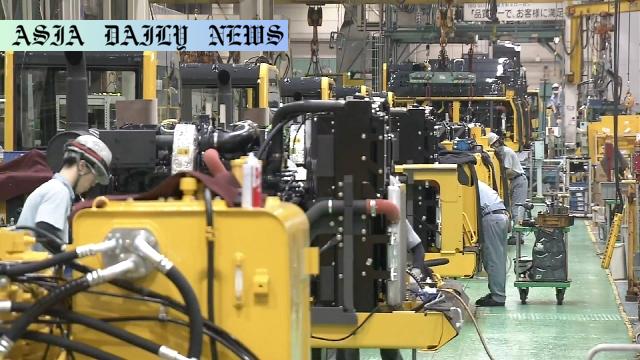Tariffs – Japanese firms see profits dip as US tariffs increase costs, with machinery and electronics sectors particularly hit.
Japanese companies forecast significant profit losses due to US tariffs.
Komatsu predicts over 94 billion yen drop in operating profit.
Hitachi plans to offset losses by regionalizing manufacturing.

Introduction: The Tariff Fallout
In recent economic developments, Japanese corporations are grappling with the financial repercussions of tariffs imposed by the United States. These additional import duties, introduced under the policy framework of former President Donald Trump, have disrupted supply chains and increased operating costs. Major players like Komatsu and Hitachi have already revised their financial forecasts, signaling a challenging fiscal year. This development underscores the intricate balance of global economics, where policy decisions in one country cascade across international borders.
Komatsu: A Construction Giant Feeling the Pinch
Komatsu, a global leader in construction machinery, has reported a bleak outlook for the fiscal year ending March 2026. The company anticipates a staggering 94 billion yen (approximately 662 million USD) decline in operating profit. This adjustment stems from a predicted sales contraction of around 52 billion yen, equating to 365 million USD. Komatsu attributes this downturn to the US tariffs that have escalated the cost of importing machinery to its American subsidiary. Notably, 50 percent of the company’s products sold in the US are imported, amplifying the financial strain. The company now faces the dual challenge of mitigating these losses while maintaining its market presence in a crucial region.
Hitachi Construction Machinery: Navigating Through Challenges
Similarly, Hitachi Construction Machinery has outlined the financial pressures it faces due to the tariffs. The company has forecasted a potential reduction in its operating profit by 30 billion yen (around 210 million USD). North America, which accounts for 23 percent of its total sales, is a critical market for Hitachi. To offset the tariff-induced costs, the company plans to implement a combination of price hikes and operational efficiencies. This strategic response reflects Hitachi’s commitment to navigating the challenges while preserving its competitive edge in the global market.
Hitachi Electronics: Strength Amidst Adversity
While the tariffs have adversely impacted Hitachi’s electronics division, the company remains optimistic about its overall financial performance. Hitachi has revised its net profit forecast for the coming year downward by 35 billion yen (around 245 million USD). Despite this adjustment, the company still anticipates recording a net profit of 710 billion yen (approximately 5 billion USD), marking a record high. This confidence is rooted in the robust performance of its infrastructure and other operations. Hitachi’s strategic focus on localizing manufacturing and material procurement is a testament to its resilience and adaptability in the face of global economic challenges.
Broader Implications and Lessons Learned
The experiences of Komatsu and Hitachi highlight the far-reaching implications of trade policies on multinational corporations. These companies’ proactive measures, such as regionalizing supply chains and adjusting pricing strategies, offer valuable lessons for other businesses navigating similar challenges. Moreover, their resilience underscores the importance of adaptability and innovation in a rapidly changing global economic landscape.
Conclusion: A Call for Collaborative Solutions
As Japanese companies continue to adapt to the new economic realities shaped by US tariffs, there is a clear need for collaborative solutions that promote equitable trade practices. Policymakers and corporations alike must work together to address these challenges and foster a more sustainable global economy. By sharing their experiences and strategies, companies like Komatsu and Hitachi can play a pivotal role in shaping a more resilient and inclusive economic future.



Commentary
Introduction: Economic Crossroads in Global Trade
The imposition of US tariffs on imports has once again underscored the interconnected nature of global supply chains and markets. Japanese corporations, recognized for their operational efficiency and global reach, are now confronting a wave of challenges spurred by these economic policies. This raises vital questions about the role of international cooperation in shaping a fair and balanced trade landscape.
The Impact on Japanese Industry
For companies like Komatsu and Hitachi, the current scenario is a remarkable test of resilience and strategy. The significant dent in their earnings forecasts reflects the profound impact of tariffs on their operations. What stands out, however, is how these challenges have prompted a rethinking of traditional business models. By prioritizing localized production and resource sourcing, these firms are demonstrating an ability to pivot and innovate amidst adversity.
Lessons for the Global Economy
The experiences of these Japanese giants are not isolated. They provide a lens into the broader economic trends and challenges faced by multinational corporations in an era of trade protectionism. The steps they are taking, from cost reductions to strategic price adjustments, offer a playbook for businesses worldwide grappling with similar dynamics. Moreover, these developments highlight the need for forward-thinking policies that consider the long-term implications of trade regulations on global commerce.
Moving Towards Collaborative Solutions
As we consider the broader implications of these developments, it becomes evident that unilateral economic policies can produce unintended consequences that ripple across borders. Collaboration and dialogue among trading partners are crucial for fostering an environment of shared growth and stability. By working together, countries and corporations can address the challenges of today while laying the groundwork for a more equitable and inclusive global economy.